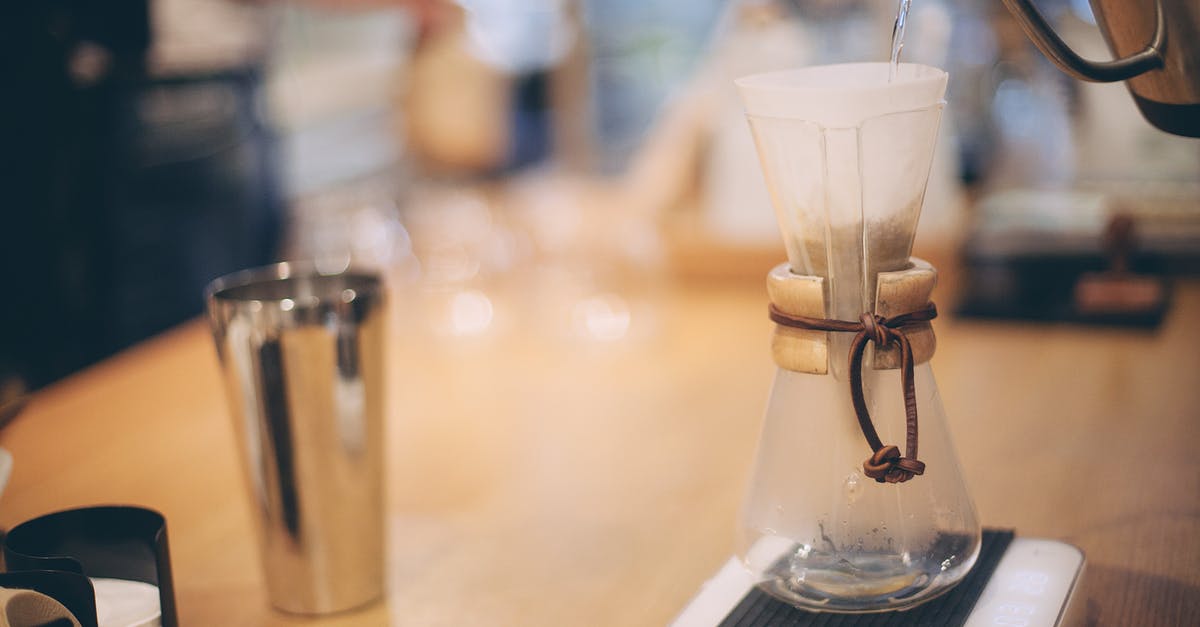french press vs. chemex - oil absorbed by chemex filters?

I've always understood the french press to be the superior way to prepare coffee because it lacks any paper/cloth filter thus leaving the flavorful and aromatic oil in the beverage. However, I've noticed a lot of my favorite coffee places now prefer chemex or pour-over style claiming it to be the best way to prepare and coffee.
Does the paper filter used in chemex's in fact absorb the coffee's oils? Does this impact the flavor/aroma of the beverage? If not, what is it about the chemex/pour-over makes it the preferred method by so many high end/gourmet coffee shops? (Aside from it's obvious visual appeal, show-like quality.)
Best Answer
The Chemex process does absorb oils, and also reduces the total time the coffee grounds stay in direct contact with hot water. But the issue is less about better-vs-worse, and more about your preferences wrt the characteristics of how you like to drink your coffee.
French Press yields, assuming all else is the same, an earthier, more viscous brew with more pronounced bitter notes that many people prefer. This is related to the presence of oils and suspended microparticles, much of which the Chemex filter removes.
Assuming the same grounds-to-water ratio and the same bean, a Chemex process will yield a coffee infusion with relatively sharper high notes, enhanced acidity and lowered bitterness. For coffee varietals and roasts that have more delicate, perfumey elements, Chemex can be a preferred method. Many coffeeshops prize these more floral, wine-like elements in their coffees and want their customers to experience them.
Besides choosing to showcase the more delicate elements of the coffee beans, many high-end coffee houses also have logistical concerns facing them as they work to assure the same coffee experience cup after cup. Assuming the patron receives a ready-to-drink (or ready-to-lighten/sweeten) cup of coffee, Chemex offers a process that is easier to measure, time, brew and dispose/clean up than French Press when presented with a stream of customers. While, French Press is easier than Chemex if you give the press to the customer to press and pour when they wish, that means the coffeeshop cannot control the final brew quality, which is often what they prize. Assuming the French Press is poured into a carafe, this problem can be ameliorated, but dumping, rinsing the pot, then unscrewing, rinsing and rescrewing the press is more challenging under time pressure than simply lifting out the Chemex filter and discarding.
Personally, I prefer French Press. I like the heavier, more viscous brew that the process yields, and I lean towards Half-City or medium roasts, which are lower in bitterness in the first place.
Here's a good example of a method very similar to what I do: http://stumptowncoffee.com/brew-guides/press-pot/
Pictures about "french press vs. chemex - oil absorbed by chemex filters?"



Is a Chemex the same as a French Press?
Unlike the French Press, the Chemex uses a paper filter. And yet, unlike a drip coffee machine \u2014 which also uses a paper filter \u2014 Chemex filters are made from specially bonded paper. While this adds to the expense of every Chemex cup, the special paper reduces the pass through of bitter solubles.Why are Chemex filters better?
Why Chemex Filters Are Better Than Regular Coffee Filters. Chemex filters are considerably heavier than regular coffee filters. They are made from laboratory-grade filter papers that are designed to remove even the finest sediment particles as well as unwanted oils and fats from your coffee.Do you need to rinse Chemex filters?
Which coffee filters should you rinse? I suggest rinsing all the coffee filters you use at home; this includes the filters of the Chemex, Hario V60, and AeroPress. Only the paper coffee filters have to be rinsed because these can leave that papery taste to your coffee.Why is there a Chemex filter shortage?
Aside from the surging demand for these products, the Covid-19 pandemic has caused disruptions in production and this unprecedented filter shortage.Chemex VS French Press - NOT SURPRISED | Java Royale
More answers regarding french press vs. chemex - oil absorbed by chemex filters?
Answer 2
Ultimately it's about preference in taste and preference in process. Some people will prefer French Press while others swear by Chemex.
The Chemex brew method can absorb oils, mainly with paper filters. Reusable filters tend to allow more oils through for a bolder taste. There's also a further level of control with this brewing method. Your pouring technique, how you bloom the grind etc. all gets taken into consideration with the final brew.
The French Press brew method mainly leaves you with a fuller cup of coffee when compared to the Chemex. It can be richer, again taking into consideration the type of coffee you're using, grind size, and the effort you put into the press itself.
Answer 3
SweetHome.com recommends pourovers and claims that
Unlike a press pot, it uses a paper filter, so you get more flavor clarity (at the expense of less body, admittedly, but flavor clarity is probably what you want if you’re spending good money on good beans).
They have specific recommendations for both manual and automatic pourovers, coffee grinders, scales and even a kettle.
They also point to an index of instructions of various brewing methods.
Answer 4
I prefer Chemex because that last sip doesn't have any particles in it. The press guarantees a mouthful of coffee sand if you want to finish your cup.
Sources: Stack Exchange - This article follows the attribution requirements of Stack Exchange and is licensed under CC BY-SA 3.0.
Images: Dziana Hasanbekava, Maria Orlova, Michael Burrows, Ron Lach
